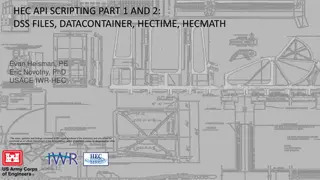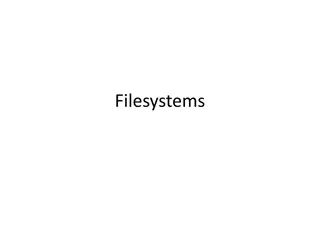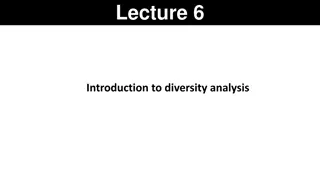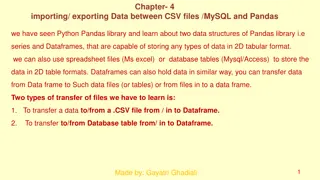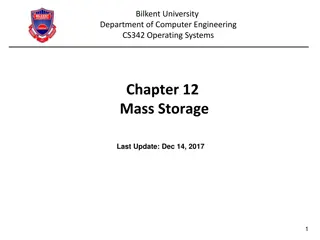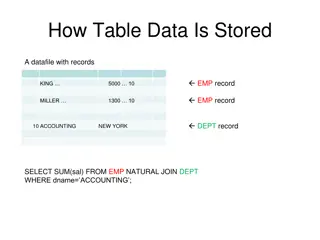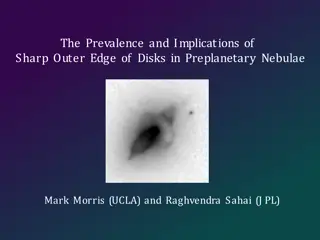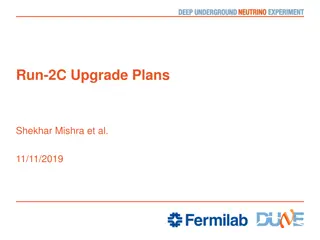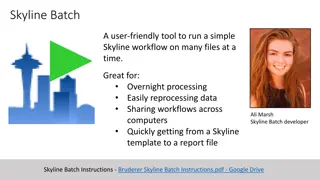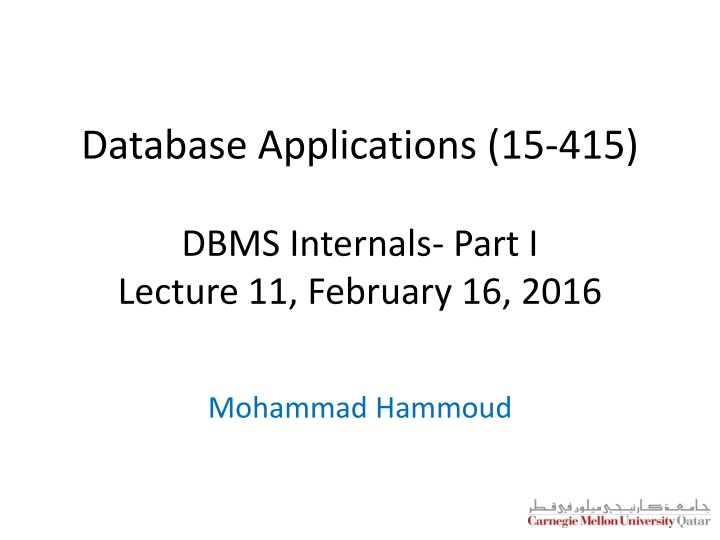
Disk Storage in Database Management Systems
Explore how database systems store data on disk, the importance of memory hierarchy in database operations, and strategies to minimize I/O time for efficient data processing. Learn about disk organizations, data storage implications, and the role of magnetic disks in storing information effectively.
Download Presentation

Please find below an Image/Link to download the presentation.
The content on the website is provided AS IS for your information and personal use only. It may not be sold, licensed, or shared on other websites without obtaining consent from the author. If you encounter any issues during the download, it is possible that the publisher has removed the file from their server.
You are allowed to download the files provided on this website for personal or commercial use, subject to the condition that they are used lawfully. All files are the property of their respective owners.
The content on the website is provided AS IS for your information and personal use only. It may not be sold, licensed, or shared on other websites without obtaining consent from the author.
E N D
Presentation Transcript
Database Applications (15-415) DBMS Internals- Part I Lecture 11, February 16, 2016 Mohammad Hammoud
Today Last Session: JDBC Today s Session: DBMS Internals- Part I Background on Disks and Disk Arrays Disk Space Management Announcements: Project 1 is due today by midnight Project 2 will be out on Thursday The Midterm exam will be held on Tuesday, Feb 23 during the class time in Room 1031 (all topics covered are included)
DBMS Layers Queries Query Optimization and Execution Relational Operators Files and Access Methods Transaction Manager Recovery Manager Buffer Management Lock Manager Disk Space Management DB Today and the Next Two Weeks
Outline Where Do DBMSs Store Data? Various Disk Organizations and Reliability and Performance Implications on DBMSs Disk Space Management
The Memory Hierarchy Storage devices play an important role in database systems How systems arrange storage? 2-3 GHZ P P Less expensive, but slower! More expensive, but faster! 16KB-64KB 2-4 Cycles L1-I L1-D L1-I L1-D 512KB-8MB 6-15 Cycles L2 Cache 4MB-32MB 30-50 Cycles L3 Cache 1GB-8GB 600+ Cycles Main Memory 160GB- 4TB 1000s of times slower Disk
Where to Store Data? Where do DBMSs store information? DBMSs store large amount of data (what about Big Data?) as of now, we assume centralized DBMSs Typically, buying enough memory to store all data is prohibitively expensive (let alone that memories are volatile) Thus, databases are usually stored on disks (or tapes for backups)
But, Is Memory Gone? Data must be brought into memory to be processed! READ: transfer data from disk to main memory (RAM) I/O Time WRITE: transfer data from RAM to disk I/O time dominates the time taken for database operations! To minimize I/O time, it is necessary to store and locate data strategically
Magnetic Disks Data is stored in disk blocks Spindle Blocks are arranged in concentric rings called tracks Tracks Disk head Sector Each track is divided into arcs called sectors (whose size is fixed) The block size is a multiple of sector size Platters Arm movement The set of all tracks with the same diameter is called cylinder Arm assembly To read/write data, the arm assembly is moved in or out to position a head on a desired track
Accessing a Disk Block What is I/O time? The time to move the disk heads to the track on which a desired block is located The waiting time for the desired block to rotate under the disk head The time to actually read or write the data in the block once the head is positioned
Accessing a Disk Block What is I/O time? The time to move the disk heads to the track on which a desired block is located Seek Time The waiting time for the desired block to rotate under the disk head Rotational Time The time to actually read or write the data in the block once the head is positioned Transfer Time I/O time = seek time + rotational time + transfer time
Implications on DBMSs Seek time and rotational delay dominate! Key to lower I/O cost: reduce seek/rotation delays! How to minimize seek and rotational delays? Blocks on same track, followed by Blocks on same cylinder, followed by Blocks on adjacent cylinder Hence, sequential arrangement of blocks of a file is a big win! More on that later
Outline Where Do DBMSs Store Data? Various Disk Organizations and Reliability and Performance Implications on DBMSs Disk Space Management
Many Disks vs. One Disk Although disks provide cheap, non-volatile storage for DBMSs, they are usually bottlenecks for DBMSs Reliability Performance How about adopting multiple disks? 1. More data can be held as opposed to one disk 2. Data can be stored redundantly; hence, if one disk fails, data can be found on another 3. Data can be accessed concurrently
Many Disks vs. One Disk Although disks provide cheap, non-volatile storage for DBMSs, they are usually bottlenecks for DBMSs Reliability Performance How about adopting multiple disks? 1. More data can be held as opposed to one disk 2. Data can be stored redundantly; hence, if one disk fails, data can be found on another 3. Data can be accessed concurrently Performance! Capacity! Reliability!
Multiple Disks Discussions on: Reliability Performance Reliability + Performance
Logical Volume Managers (LVMs) But, disk addresses used within a file system are assumed to refer to one particular disk (or sub-disk) What about providing an abstraction that makes a number of disks appear as one disk? LVM Disk Disk
Logical Volume Managers (LVMs) LVM Disk Disk Disk What can LVMs do? Spanning: LVM transparently maps a larger address space to different disks Mirroring: Each disk can hold a separate, identical copy of data LVM directs writes to the same block address on each disk LVM directs a read to any disk (e.g., to the less busy one)
Logical Volume Managers (LVMs) LVM Disk Disk Disk What can LVMs do? Spanning: LVM transparently maps a larger address space to different disks Mirroring: Each disk can hold a separate, identical copy of data LVM directs writes to the same block address on each disk LVM directs a read to any disk (e.g., to the less busy one) Mainly Provides Redundancy!
Multiple Disks Discussions on: Reliability Performance Reliability + Performance
Data Striping To achieve parallel accesses, we can use a technique called data striping Logical File 0 1 2 3 4 5 6 7 8 9 10 11 12 13 14 15 Stripe Length = # of disks Striping Unit 0 4 8 12 1 5 9 13 2 6 10 14 3 7 11 15 Disk 1 Disk 2 Disk 3 Disk 4
Data Striping To achieve parallel accesses, we can use a technique called data striping Client I: 512K write, offset 0 Client II: 512K write, offset 512 0 1 2 3 4 5 6 7 8 9 10 11 12 13 14 15 0 4 1 5 2 6 3 7 8 12 9 13 10 14 11 15 0 4 8 12 1 5 9 13 2 6 10 14 3 7 11 15 Disk 1 Disk 2 Disk 3 Disk 4
Data Striping Disk 1 Unit 1 Unit 5 Unit 9 Unit 13 Unit 17 Disk 2 Unit 2 Unit 6 Unit 10 Unit 14 Unit 18 Disk 3 Unit 3 Unit 7 Unit 11 Unit 15 Unit 19 Disk 4 Unit 4 Unit 8 Unit 12 Unit 16 Unit 20 Stripe 1 Stripe 2 Stripe 3 Stripe 4 Stripe 5 Each stripe is written across all disks at once Typically, a unit is either: - A bit Bit Interleaving - A byte Byte Interleaving - A block Block Interleaving
Striping Unit Values: Tradeoffs Small striping unit values Higher parallelism (+) Smaller amount of data to transfer (+) Increased seek and rotational delays (-) 1 1 1 1 2 2 2 2 3 3 3 3 4 4 4 4 Disk 1 Disk 2 Disk 3 Disk 4
Striping Unit Values: Tradeoffs Large striping unit values Lower parallelism (-) Larger amount of data to transfer (-) Decreased seek and rotational delays (+) A request can be handled completely on a separate disk! (- or +) But, multiple requests could be satisfied at once! (+) 1 2 3 4 Disk 1 Disk 2 Disk 3 Disk 4
Striping Unit Values: Tradeoffs Large striping unit values Lower parallelism Larger amount of data to transfer Decreased seek and rotational delays A request can be handled completely on a separate disk! But, multiple requests could be satisfied at once! Number of requests = Concurrency Factor 1 2 3 4 Disk 1 Disk 2 Disk 3 Disk 4
Multiple Disks Discussions on: Reliability Performance Reliability + Performance
Redundant Arrays of Independent Disks A system depending on N disks is much more likely to fail than one depending on one disk If the probability of one disk to fail is f Then, the probability of N disks to fail is (1-(1-f)N) How would we combine reliability with performance? Redundant Arrays of Inexpensive Disks (RAID) combines mirroring and striping Nowadays, Independent!
RAID Level 0 Data Striping
RAID Level 1 Data Mirroring
RAID Level 2 Data Data bits Bit Interleaving; ECC Check bits
RAID Level 3 Data Data bits Bit Interleaving; Parity Parity bits
RAID Level 4 Data Data blocks Block Interleaving; Parity Parity blocks
RAID Level 5 Data Data and parity blocks Block Interleaving; Parity
RAID 4 vs. RAID 5 What if we have a lot of small writes? RAID 5 is the best What if we have mostly large writes? Multiples of stripes Either is fine What if we want to expand the number of disks? RAID 4: add a disk and re-compute parity RAID 5: add a disk, re-compute parity, and shuffle data blocks among all disks to reestablish the check-block pattern (expensive!)
Beyond Disks: Flash Flash memory is a relatively new technology providing the functionality needed to hold file systems and DBMSs It is writable It is readable Writing is slower than reading It is non-volatile Faster than disks, but slower than DRAMs Unlike disks, it provides random access Limited lifetime More expensive than disks
Outline Where Do DBMSs Store Data? Various Disk Organizations and Reliability and Performance Implications on DBMSs Disk Space Management
DBMS Layers Queries Query Optimization and Execution Relational Operators Files and Access Methods Transaction Manager Recovery Manager Buffer Management Lock Manager Disk Space Management DB
Disk Space Management DBMSs disk space managers Support the concept of a page as a unit of data Page size is usually chosen to be equal to the block size so that reading or writing a page can be done in 1 disk I/O Allocate/de-allocate pages as a contiguous sequence of blocks on disks Abstracts hardware (and possibly OS) details from higher DBMS levels
What to Keep Track of? The DBMS disk space manager keeps track of: Which disk blocks are in use Which pages are on which disk blocks Blocks can be initially allocated contiguously, but allocating and de-allocating blocks usually create holes Hence, a mechanism to keep track of free blocks is needed A list of free blocks can be maintained (storage could be an issue) Alternatively, a bitmap with one bit per each disk block can be maintained (more storage efficient and faster in identifying contiguous free areas!)
OS File Systems vs. DBMS Disk Space Managers Operating Systems already employ disk space managers using their file abstraction Read byte i of file f read block m of track t of cylinder c of disk d DBMSs disk space managers usually pursue their own disk management without relying on OS file systems Enables portability Can address larger amounts of data Allows spanning and mirroring
Next Class Queries Query Optimization and Execution Buffer Management and Parts of Files and Access Methods Relational Operators Files and Access Methods Transaction Manager Recovery Manager Buffer Management Lock Manager Disk Space Management DB


